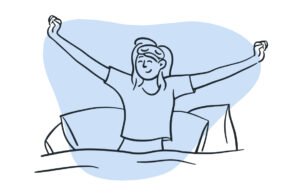I Tried Living Like a Wolf Chronotype for a Week
Disclosure: By clicking on the product links in this article, Mattress Nerd may receive a commission fee at no cost to you, the reader. Read full disclosure statement.
Most people have heard of the “morning bird” and the “night owl” to describe your body’s inclination to get up early or stay up late. This tendency toward a certain sleep schedule is called a chronotype.
Dr. Michael Breus developed a system for understanding chronotypes that breaks it down into four groups, each represented by a different animal: lion, bear, wolf, and dolphin. He also outlined the basic routines that would work best for them, and I wanted to put my chronotype’s schedule to the test.
Here’s what I learned from my experience living like the wolf chronotype.
Finding my Animal Chronotype
To find out what animal my chronotype aligns with, I started by taking a few online chronotype quizzes. I had results for both bears and wolves depending on the structure of the quizzes, but after reading the descriptions of the different options, I knew I was definitely a wolf.
Based on my preferred schedule of staying up late and sleeping in and my highest energy levels in the afternoon and evening, I knew the wolf chronotype fit my lifestyle the closest. Next, it was time to implement the wolf schedule and see if it impacted my energy or mood.
Interested in learning more about the science behind chronotypes? Check out our interview with sleep expert, Dr. Jade Wu.
The Wolf Chronotype Schedule
This sample schedule is based on one from Casper, with supplementary times for eating, exercising, and caffeinating from a TedTalk by Dr. Breus. Here’s how I structured my days.
- Wake up/Breakfast: 8:00 a.m.
- Light work: 10:00 a.m. – 12:00 p.m.
- Caffeine: 12:00 p.m.
- Deep/Creative Work: 12:00 p.m. – 2:00 p.m.
- Lunch: 1:00 p.m.
- Light work: 2:00 p.m. – 5:00 p.m.
- Deep/Creative Work: 5:00 p.m. – 9:00 p.m.
- Exercise: 6:00 p.m.
- Dinner: 8:00 p.m.
- Unwind: 10 p.m.
- Sleep: 12:00 a.m.
Living like the Wolf Chronotype
I spent a week basing my schedule on the recommendations for the wolf chronotype. Here’s how I switched up my routine and the changes I noticed in my productivity and energy levels.
Bottom Line: How Did Living Like My Chronotype Work?
I felt like this schedule generally helped me make the most of my body’s natural energy level changes. I did notice, though, that this schedule tends to put me out of step with the majority of the rest of the world. Getting buy-in from my coworkers and family to reframe my days around this schedule was really helpful.
Working
- 12 p.m. – 2 p.m.
- 6 p.m. – 9 p.m.
Wolves tend to be super creative, but their productivity schedules don’t really align with the typical 9-5 job. Folks whose chronotypes skew later tend to do their best deep work around midday and right around dinner.
For me, that meant concentrating on as much deep creative work as possible into the early afternoon. My job is pretty project-based, so taking advantage of this short burst of productivity to get a lot of projects accomplished worked well for me. Since I had an extra burst of energy after my 9-5 job was done, I used the opportunity to get household chores done and work on my own personal creative projects.
Eating
Breakfast – 8:00 a.m.
I like to eat breakfast as soon as I wake up, so this part of the schedule worked well for me without any changes. I tend to wake up immediately hungry, and even though I don’t feel awake right after eating, it helps me feel more ready for the day.
The hard part? Not having coffee with my breakfast. Since the wolf schedule recommends waiting to have your first caffeine until noon, I had to skip my typical morning cup of joe.
Lunch – 1:00 p.m.
Waiting until 1:00 p.m. for lunch was a harder adjustment than I expected. I usually eat lunch at noon and have a second coffee around 2:00 p.m., so I didn’t think shifting that by an hour or so would be that disruptive.
To transition to a later lunch, I added a snack at about 11 a.m. to help hold me over until it was time for another meal and make sure I wasn’t drinking coffee on an empty stomach. The 1 p.m. meal didn’t line up with my typical lunch break, so I had to reschedule some meetings in order to accommodate eating later.
Once I made those adjustments, I found that the later lunch worked well for helping me sustain my energy levels for several hours instead of crashing at 2 p.m.
Dinner – 8:00 p.m.
Personally, I liked the timing of this dinnertime. Especially while following this schedule, I get a big burst of energy around 6 p.m. That means I’m either working out or diving into a creative project after I sign off from work. By the time I’m naturally getting hungry and ready to switch gears and make dinner, eating at 8 p.m. makes perfect sense.
In practice, though, this isn’t always possible. Most of my family and friends are the bear chronotype, which means they have more energy earlier in the day and have an earlier optimal dinnertime. Since it’s almost always just me who follows more of a wolf schedule, I’ll usually end up eating before 8 p.m. if I don’t want to eat alone.
Caffeine
When to Drink Caffeine
- 12:00 p.m. – 2:00 p.m.
Delaying caffeine was, as I expected, one of the hardest parts about living this schedule. Typically, I’ll wait about 30 minutes after waking up to have my first cup. In order to follow Dr. Breus’ guidelines, though, I had to wait four hours!
Since my mornings were slated for light work, this didn’t impact my performance on most days. Work can be unpredictable, though, and sometimes an urgent task would come up first thing, and not having coffee made me feel slower to react than I would’ve liked.
I did find that substituting a morning coffee for a mug of hot lemon water gave me the familiar, comforting experience of my coffee without the caffeine interfering with my natural hormone levels.
Exercise
- 6:00 p.m.
Exercising after work and before dinner was already in line with my routine. I typically play pickleball or go for a longer walk with my dog around 5 p.m., so moving this to 6 wasn’t a big shift.
I like to wait until the evening to work out because that’s when I feel like I have the most physical energy, and this schedule only helped support that.
How to Leverage Your Chronotype
Syncing your schedule to your chronotype can be a fun and rewarding exercise. Even if you don’t end up following every element for the long haul, you might find a few insights about how to structure your day to support higher energy levels.
1. Find your Chronotype
I’d recommend taking a few different online chronotype quizzes but don’t take your answers too seriously. For example, the weighting of certain questions on different quizzes can influence your results pretty heavily. Try comparing your common results with the descriptions of each chronotype and what you know about your own experience.
2. Pick a Wake-Up and Bed Time that Works for You
Depending on your chronotype, your alarm might go off at the crack of dawn, or it may not be until much later. Either way, plan wake-up and bedtimes that both allow you to get a full night’s sleep and make sure you can stick to your responsibilities during the day.
3. Wait to Have Caffeine
If you’re used to having your coffee or tea first thing in the morning, you’re not taking advantage of your body’s natural wakeful hormone surge. Instead, try delaying your first cup until at least 90 minutes after you wake up to allow your cortisol levels to do their job in the morning, and then use the caffeine boost when they’ve dipped down.
4. Keep Your Routine Consistent
Getting your schedule in line with your chronotype could be great for your energy and productivity, but it may take some time for your body to adjust. In order to consistently stick to this schedule, you might need permission at work or to communicate with family and friends about your schedule and why it works best for you.


